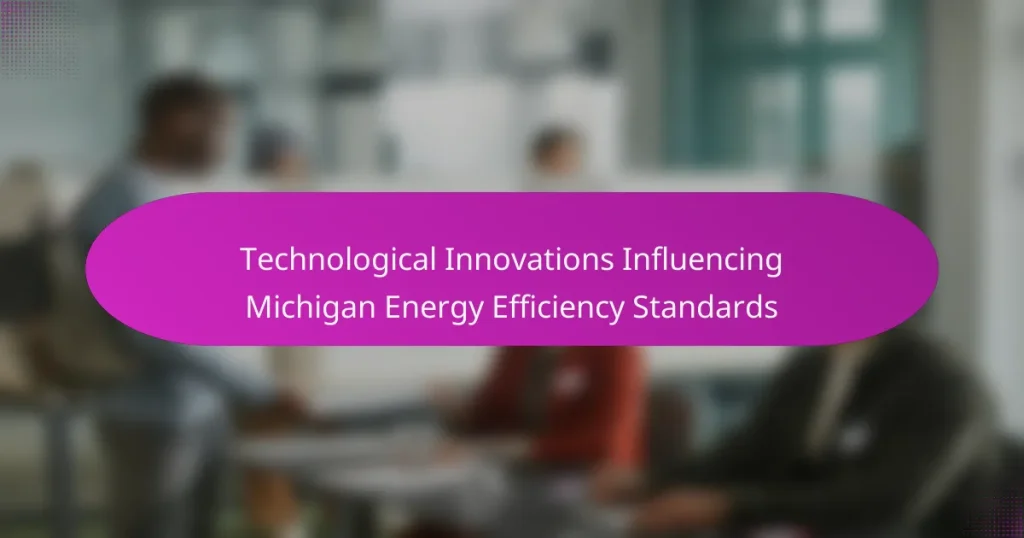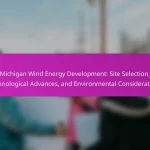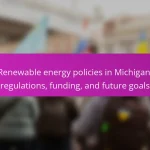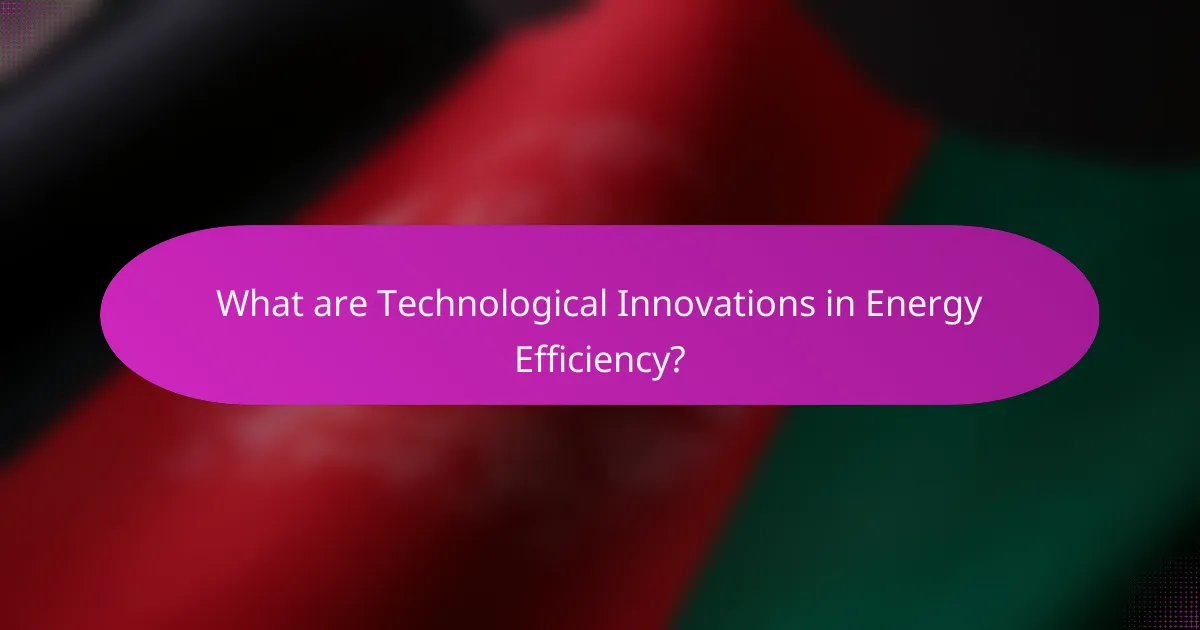
What are Technological Innovations in Energy Efficiency?
Technological innovations in energy efficiency refer to advancements that reduce energy consumption while maintaining performance. These innovations include smart grid technology, which optimizes electricity distribution. Energy-efficient appliances, such as LED lighting, consume less power than traditional options. Building automation systems enhance energy management in commercial spaces. Renewable energy sources like solar panels improve overall energy efficiency. Advanced insulation materials reduce heating and cooling demands. Energy management software allows for real-time monitoring of energy use. According to the U.S. Department of Energy, implementing these technologies can lead to significant energy savings, often exceeding 30% in various applications.
How do these innovations impact Michigan’s energy standards?
Innovations in technology significantly enhance Michigan’s energy standards. These advancements lead to improved energy efficiency, reducing overall consumption. For instance, the adoption of smart grids allows for better energy management. This technology enables real-time monitoring and adjustments to energy use. Additionally, renewable energy sources, such as solar and wind, are increasingly integrated into the state’s energy mix. This shift supports Michigan’s commitment to reducing greenhouse gas emissions. According to the Michigan Energy Efficiency Plan, these innovations can lead to a 20% reduction in energy usage by 2025. Overall, technological advancements drive Michigan towards more sustainable energy practices.
What specific technologies are leading the charge in energy efficiency?
Smart grids are leading the charge in energy efficiency. They utilize advanced communication technologies to optimize electricity distribution. Smart meters provide real-time data on energy consumption. This allows consumers to adjust usage based on demand. Energy-efficient lighting, such as LED technology, significantly reduces electricity use. HVAC systems with variable speed drives enhance efficiency in heating and cooling. Renewable energy technologies, like solar panels, contribute to reduced reliance on fossil fuels. Energy storage solutions, such as batteries, help balance supply and demand. According to the U.S. Department of Energy, these technologies can lead to a 30% reduction in energy consumption.
How do these technologies compare to traditional energy solutions?
Technological innovations in energy efficiency offer advantages over traditional energy solutions. These technologies often provide higher efficiency rates, reducing energy consumption. For instance, LED lighting can use up to 75% less energy than incandescent bulbs. Additionally, renewable energy sources like solar and wind have lower environmental impacts compared to fossil fuels. Traditional solutions typically rely on non-renewable resources, contributing to greenhouse gas emissions. In contrast, modern technologies often integrate smart grid systems that enhance energy distribution efficiency. The U.S. Department of Energy states that smart technologies can reduce energy costs by up to 20%. Overall, innovative energy solutions present a more sustainable and efficient alternative to conventional methods.
Why are energy efficiency standards important for Michigan?
Energy efficiency standards are crucial for Michigan to reduce energy consumption and lower utility costs. These standards promote the use of energy-efficient appliances and building practices. In 2021, Michigan’s energy efficiency programs saved over 1.5 billion kilowatt-hours of electricity. This reduction translates to significant savings for consumers and businesses. Energy efficiency also contributes to environmental sustainability by decreasing greenhouse gas emissions. The Michigan Public Service Commission supports these standards to enhance energy security and reliability. By adhering to efficiency standards, Michigan can foster economic growth and job creation in the clean energy sector.
What role do these standards play in environmental sustainability?
Energy efficiency standards play a crucial role in environmental sustainability. They establish benchmarks for reducing energy consumption and greenhouse gas emissions. By mandating higher efficiency in appliances and buildings, these standards promote the use of cleaner technologies. For instance, according to the U.S. Department of Energy, energy efficiency improvements can lead to a reduction of 2.2 billion metric tons of carbon dioxide emissions by 2030. Additionally, these standards encourage innovation in energy-saving technologies. They drive investments in research and development, leading to more sustainable practices across industries. Overall, effective energy efficiency standards contribute significantly to mitigating climate change and conserving natural resources.
How do energy efficiency standards affect consumer costs?
Energy efficiency standards generally reduce consumer costs over time. These standards mandate minimum efficiency levels for appliances and buildings. As a result, consumers save money on utility bills. For example, Energy Star-rated appliances can save households up to 30% on energy costs. Additionally, the initial investment in energy-efficient products is often offset by long-term savings. According to the U.S. Department of Energy, energy-efficient homes can lower energy usage by 20-30%. This leads to lower monthly energy bills for consumers. Therefore, energy efficiency standards positively impact consumer costs by promoting savings through reduced energy consumption.
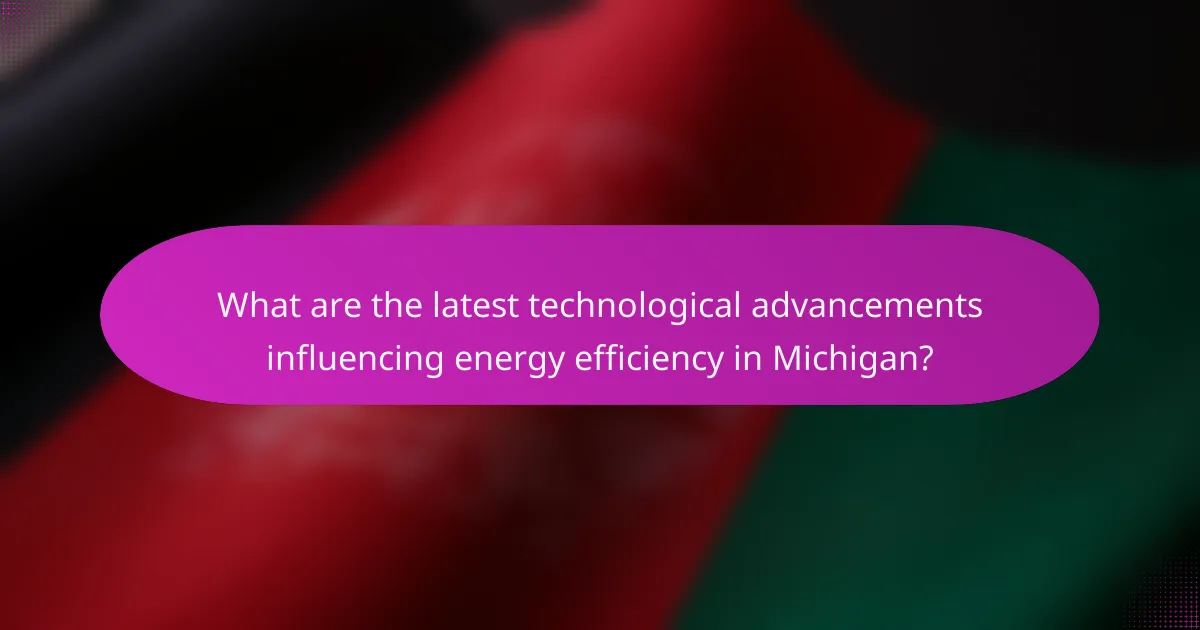
What are the latest technological advancements influencing energy efficiency in Michigan?
Recent technological advancements influencing energy efficiency in Michigan include smart grid technology, energy storage systems, and advanced building materials. Smart grid technology enhances energy distribution and management. It integrates renewable energy sources and optimizes energy use through real-time data. Energy storage systems, such as batteries, enable better management of energy supply and demand. They store excess energy generated from renewables for later use. Advanced building materials, including insulation and energy-efficient windows, reduce energy consumption in residential and commercial buildings. According to the Michigan Energy Office, these innovations are crucial for achieving state energy efficiency goals.
How is smart technology transforming energy consumption?
Smart technology is transforming energy consumption by enabling real-time monitoring and control of energy use. Smart meters provide consumers with detailed insights into their energy consumption patterns. This data allows users to adjust their usage to reduce costs and conserve energy. Smart thermostats optimize heating and cooling based on occupancy and preferences, leading to significant energy savings. Additionally, smart appliances can operate during off-peak hours, further decreasing energy demand. According to the U.S. Department of Energy, smart technologies can reduce energy consumption by up to 30%. Overall, these innovations contribute to improved energy efficiency and sustainability.
What examples of smart technology are being implemented in Michigan?
Smart technology implementations in Michigan include smart meters and advanced energy management systems. Smart meters allow for real-time monitoring of energy consumption. They provide users with detailed insights into their energy usage patterns. Advanced energy management systems optimize energy distribution in homes and businesses. These systems use data analytics to enhance energy efficiency. Michigan has also integrated smart grid technology to improve electrical grid reliability. This technology facilitates better communication between energy providers and consumers. Additionally, Michigan is deploying smart streetlights that adjust brightness based on traffic conditions. These implementations aim to reduce energy waste and improve overall efficiency.
How do smart technologies enhance user engagement in energy efficiency?
Smart technologies enhance user engagement in energy efficiency by providing real-time data and feedback. These technologies include smart meters and home energy management systems. They allow users to monitor their energy consumption instantly. This immediate access to information encourages users to adjust their behavior. For example, users can see how turning off lights or adjusting thermostats affects their energy use. Studies show that real-time feedback can reduce energy consumption by up to 15%. Additionally, gamification elements in smart technologies motivate users to achieve energy-saving goals. This engagement leads to more sustainable habits over time.
What renewable energy sources are being integrated into Michigan’s energy efficiency efforts?
Michigan is integrating wind, solar, and biomass energy sources into its energy efficiency efforts. Wind energy has seen significant growth, with over 1,000 MW installed capacity as of 2021. Solar energy installations have also increased, with a target to reach 10% of the state’s energy mix by 2025. Biomass energy, derived from organic materials, contributes to reducing waste and generating renewable power. These renewable sources are part of Michigan’s strategy to meet its energy efficiency goals. The state aims to reduce greenhouse gas emissions and enhance energy security through these initiatives.
How do solar and wind technologies contribute to energy standards?
Solar and wind technologies enhance energy standards by increasing renewable energy generation. They contribute to reducing greenhouse gas emissions. Solar energy systems can provide significant power output, with installations averaging around 300 watts per panel. Wind turbines can generate electricity at a capacity factor of 35% to 45%, depending on location. These technologies also promote energy independence and resilience. They support compliance with state energy policies and standards, like Michigan’s Clean and Renewable Energy Standard. The integration of solar and wind into the energy mix helps achieve sustainability goals set by regulatory bodies.
What are the challenges of integrating renewable sources into existing systems?
Integrating renewable sources into existing systems faces several challenges. One major challenge is the variability of renewable energy production. Sources like solar and wind are dependent on weather conditions. This unpredictability can lead to supply inconsistencies. Another challenge is the need for infrastructure upgrades. Many existing systems require modifications to accommodate renewable energy inputs. Additionally, energy storage solutions are often inadequate. Current battery technologies may not store enough energy for peak demand. Regulatory barriers also complicate integration. Existing policies may not favor renewable energy adoption. Lastly, there is a skills gap in the workforce. Technicians may lack training in new renewable technologies. These challenges must be addressed to enhance energy efficiency in Michigan.
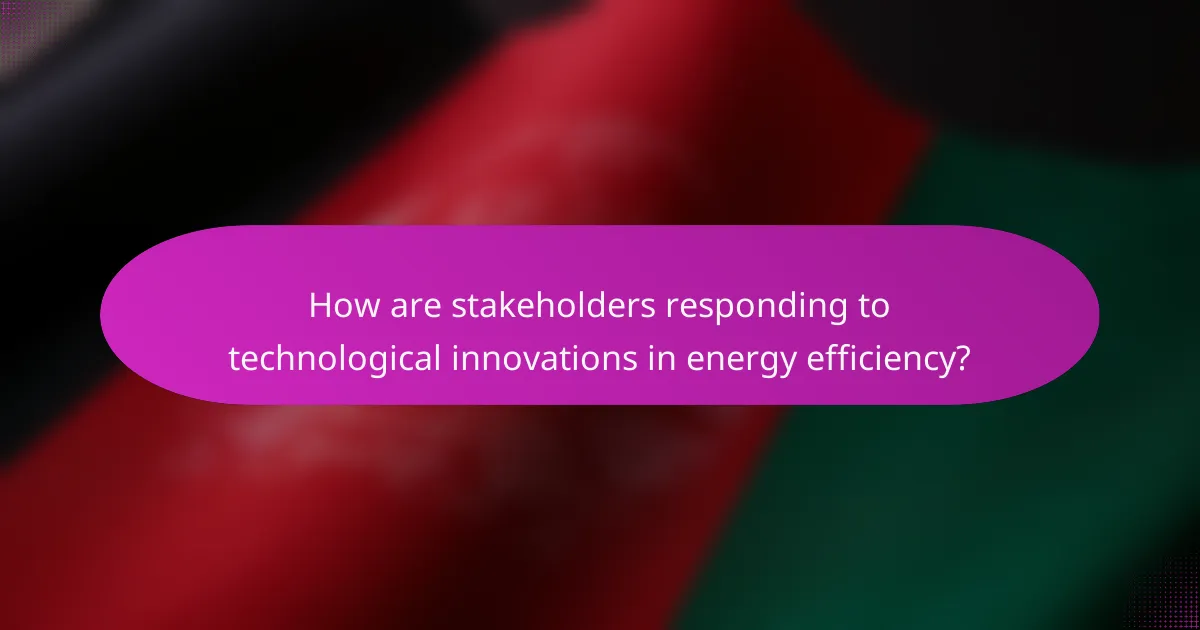
How are stakeholders responding to technological innovations in energy efficiency?
Stakeholders are increasingly adopting technological innovations in energy efficiency to enhance sustainability. Utilities are investing in smart grid technologies to optimize energy distribution. Businesses are implementing energy management systems to reduce consumption and costs. Policymakers are creating incentives for adopting energy-efficient technologies. Research indicates that energy-efficient innovations can reduce energy consumption by up to 30%. Consumers are increasingly choosing energy-efficient products, influenced by rising energy costs. Collaboration among stakeholders is fostering innovation and improving energy efficiency standards. These responses reflect a collective commitment to reducing environmental impact and promoting economic benefits.
What roles do government policies play in promoting these innovations?
Government policies play a crucial role in promoting technological innovations in energy efficiency. They provide funding and incentives for research and development. For example, tax credits and grants encourage companies to invest in new technologies. Policies also establish regulations that set energy efficiency standards. These standards push manufacturers to innovate in order to comply. Furthermore, government initiatives can foster collaboration between public and private sectors. This collaboration often leads to the sharing of knowledge and resources. Additionally, policies can promote public awareness of energy-efficient technologies. Increased awareness can drive consumer demand for innovative solutions. Overall, government policies create an environment conducive to innovation in energy efficiency.
How have recent policy changes affected energy efficiency standards?
Recent policy changes have strengthened energy efficiency standards. These changes include updated regulations that require higher efficiency ratings for appliances and buildings. For instance, the U.S. Department of Energy increased efficiency requirements for residential water heaters in 2020. This shift aims to reduce energy consumption and greenhouse gas emissions. Additionally, states like Michigan have implemented stricter codes for new construction and renovations. These codes promote the use of advanced technologies and materials that enhance energy performance. As a result, consumers can expect lower utility bills and improved comfort in their homes. Overall, these policy updates drive innovation and investment in energy-efficient technologies.
What incentives are available for adopting energy-efficient technologies?
Incentives for adopting energy-efficient technologies include tax credits, rebates, and grants. Tax credits can reduce the amount of income tax owed. For example, the Federal Investment Tax Credit allows for a percentage of the cost of solar systems to be deducted from federal taxes. Rebates are offered by utility companies to customers who purchase energy-efficient appliances or systems. These rebates can cover a significant portion of the purchase cost. Grants may be available through state or local programs to support energy-efficient upgrades. Such incentives aim to lower initial costs and encourage the transition to more efficient technologies. According to the U.S. Department of Energy, these financial incentives significantly boost the adoption of energy-efficient practices.
What are the implications for businesses and consumers?
Technological innovations influencing Michigan energy efficiency standards have significant implications for businesses and consumers. Businesses may experience reduced operational costs due to lower energy consumption. This can enhance their competitive edge in the market. Consumers are likely to benefit from lower utility bills as energy-efficient technologies become more prevalent. Additionally, there may be an increase in the availability of energy-efficient products, leading to more choices for consumers.
The implementation of these standards can also drive innovation within industries, prompting businesses to invest in new technologies. According to the U.S. Department of Energy, energy efficiency improvements can lead to a projected savings of $1.2 trillion for U.S. consumers by 2030. This indicates a clear financial incentive for both parties involved. Overall, the shift towards energy efficiency fosters a more sustainable environment while providing economic benefits.
How can businesses leverage new technologies to meet energy standards?
Businesses can leverage new technologies to meet energy standards by adopting smart energy management systems. These systems utilize real-time data to optimize energy use and reduce waste. For example, IoT devices can monitor energy consumption patterns. This allows businesses to identify inefficiencies and implement targeted solutions. Additionally, renewable energy technologies, such as solar panels, can be integrated to lower reliance on non-renewable sources. According to the U.S. Department of Energy, buildings that implement energy-efficient technologies can reduce energy consumption by up to 30%. This not only helps meet energy standards but also lowers operational costs. Furthermore, energy-efficient appliances and lighting can contribute significantly to compliance. By embracing these innovations, businesses can enhance sustainability and meet regulatory requirements effectively.
What practical steps can consumers take to improve their energy efficiency?
Consumers can improve their energy efficiency by adopting several practical steps. First, they should replace incandescent bulbs with LED lighting. LED bulbs use up to 80% less energy and last significantly longer. Second, consumers can utilize smart thermostats to optimize heating and cooling. These devices can save about 10-12% on heating costs and 15% on cooling costs annually. Third, sealing gaps and adding insulation can reduce energy loss. Proper insulation can lower energy bills by up to 20%. Fourth, using energy-efficient appliances can make a significant impact. Energy Star-rated appliances use 10-50% less energy than standard models. Fifth, consumers should consider renewable energy sources, like solar panels. Installing solar panels can reduce electricity bills by 50-90%. Lastly, consumers should regularly maintain heating and cooling systems. Routine maintenance can improve efficiency by up to 30%. These steps collectively contribute to enhanced energy efficiency and reduced environmental impact.
Technological innovations in energy efficiency are advancements that reduce energy consumption while maintaining performance, significantly impacting Michigan’s energy standards. Key technologies include smart grid systems, energy-efficient appliances like LED lighting, and renewable energy sources such as solar and wind. These innovations lead to substantial energy savings, enhance sustainability, and drive compliance with energy efficiency standards, ultimately benefiting both businesses and consumers through reduced operational costs and lower utility bills. The article will explore the implications of these technologies, the role of government policies, and practical steps for consumers to improve energy efficiency.
